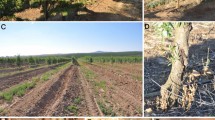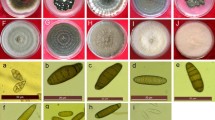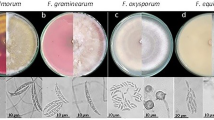Abstract
A selective agar medium based on macerated date fruits was developed for the isolation, enumeration and morphological identification of Fusarium proliferatum from soil and from infected tissues of various plants (including: onion bulbs, corn ears and stems, and various weed tissues). The selective date medium enhances the formation of polyphialide and longer chains of conidia for better separation from other related Fusarium species which also grow and proliferate on this medium. Furthermore, the date medium enables microscopic distinction among other closely related Fusarium species, e.g. F. oxysporum and F. verticillioides. Fruits of the date cultivars Medjoul and Deglet Noor provided the most useful results as compared with other cultivars tested. The date medium can serve as a selective medium for direct isolation and enumeration of F. proliferatum, as it suppresses the development of other soil fungi and plant pathogens such as Macrophomina phaseolina, Sclerotium rolfsii and Rhizoctonia solani, as well as bacteria.


Similar content being viewed by others
References
Bacon, C. W., & Hinton, D. M. (1996). Symptomless endophytic colonization of maize by Fusarium moniliforme. Canadian Journal of Botany, 74, 1195–1202.
Dhingra, O., & Sinclair, J. B. (1986). Basic plant pathology methods. Boca Raton, FL, USA: CRC Press, Inc.
Elmer, W. H. (2001). Seeds as vehicles for pathogen importation. Biological Invasions, 3, 263–271.
Fanelli, F., Schmidt-Heydt, M., Haidukowski, M., Geisen, R., Logrieco, A., & Mulè, G. (2012). Influence of light on growth, fumonisin biosynthesis and FUM1 gene expression by Fusarium proliferatum. International Journal of Food Microbiology, 153, 148–153.
Gamliel, A., & Katan, J. (1991). Involvement of fluorescent pseudomonads and other microorganisms in increased growth response of plants in solarized soils. Phytopathology, 81, 494–502.
Gamliel, A., Stack, J. P., Fletcher, J., Isack, Y., Moncrief, I., Dehne, H., et al. (2013). Fusarium proliferatum - Allium cepa pathosystem: a model encompassing crop protection, agricultural biosecurity and animal/human health. 10th International Congress of Plant Pathology (ICPP), Beijing, China.
Glenn, A. E. (2007). Mycotoxigenic Fusarium species in animal feed. Animal Feed Science and Technology, 137, 213–240.
Jurado, M., Vázquez, C., Marin, S., Sanchis, V., & Teresa González-Jaén, M. (2006). PCR-based strategy to detect contamination with mycotoxigenic Fusarium species in maize. Systematic and Applied Microbiology, 29, 681–689.
Komada, H. (1975). Development of a selective medium for quantitative isolation of Fusarium oxysporum from natural soil. Review of Plant Protection Research, 8, 114–125.
Kvas, M., Mrasas, W. F. O., Wingfield, B. D., Wingfield, M. J., & Steenkamp, E. T. (2009). Diversity and evolution of Fusarium species in the Gibberella fujikuroi complex. Fungal Diversity, 34, 1–21.
Logrieco, A., Bottalico, A., Mulè, G., Moretti, A., & Perrone, G. (2003). Epidemiology of toxigenic fungi and their associated mycotoxins for some Mediterranean crops. European Journal of Plant Pathology, 109, 645–667.
Moncrief, I., Garzon, C., Marek, S., Stack, J., Gamliel, A., Isack, Y., et al. (2013). Specific discrimination of Fusarium proliferatum using inter-simple sequence repeats (ISSRs) and simple sequence repeats (SSRs). APS Joint Meeting (Austin, TX, USA).
Munkvold, G. P. (2003). Epidemiology of Fusarium diseases and their mycotoxins in maize ears. European Journal of Plant Pathology, 109, 705–713.
Nelson, P. E. (1992). Taxonomy and biology of Fusarium moniliforme. Mycopathologia, 117, 29–36.
Nirenberg, H. I., & O’Donnell, K. (1998). New Fusarium species and combinations within the Gibberella fujikuroi species complex. Mycologia, 90, 434–458.
Sampietro, D. A., Marín, P., Iglesias, J., Presello, D. A., Vattuono, M. A., Catalan, C. A. N., et al. (2010). A molecular ased strategy for rapid diagnosis of toxigenic Fusarium species associated to cereal grains from Argentina. Fungal Biology, 114, 74–81.
Stankovic, S., Levic, J., Petrovic, T., Logrieco, A., & Moretti, A. (2007). Pathogenicity and mycotoxin production by Fusarium proliferatum isolated from onion and garlic in Serbia. The European Journal of Plant Pathology, 118, 165–172.
Triky-Dotan, S., Austerweil, M., Steiner, B., Peretz-Alon, Y., Katan, J., & Gamliel, A. (2007). Generation and dissipation of methyl isothiocyanate in soils following metam sodium fumigation: Impact on Verticillium control and potato yield. Plant Disease, 91, 497–503.
Tsao, P. H. (1970). Selective media for isolation of pathogenic fungi. Annual Review of Phytopathology, 8, 157–186.
Acknowledgments
The authors wish to thank Ori Mishly and the field crew of Kibbutz Yotvata for their valuable support. The research leading to these results has received funding from the European Union Seventh Framework Programme (FP7/2007-2013) under grant agreement no. 261752. Contribution no. 749/13 from the Agricultural Research Organization, Institute of Agricultural Engineering, Bet Dagan, Israel.
Author information
Authors and Affiliations
Corresponding author
Rights and permissions
About this article
Cite this article
Isack, Y., Benichis, M., Gillet, D. et al. A selective agar medium for isolation, enumeration and morphological identification of Fusarium proliferatum . Phytoparasitica 42, 541–547 (2014). https://doi.org/10.1007/s12600-014-0392-7
Received:
Accepted:
Published:
Issue Date:
DOI: https://doi.org/10.1007/s12600-014-0392-7




